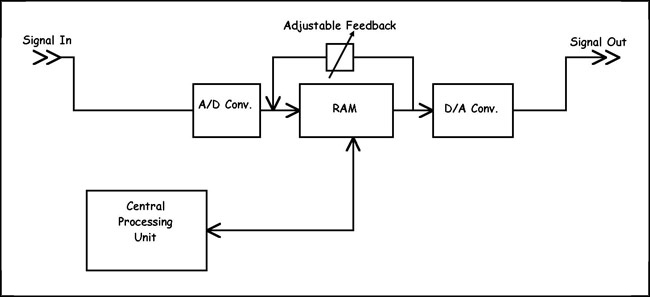The HAMMOND ORGAN
North Suburban HAMMOND ORGAN Service
Digital delay is really where the more interesting digital signal processing effects happen among which are echo, reverberation, chorus, and vibrato to name a few. Digital delay is accomplished by using a temporary or short term digital memory where the digital information represented by the audio signal gets stored for a while. Retrieving the contents of the memory after a time lapse results in a delay.

Figure 3, above, simplified block diagram of a digital delay suitable for echo production.
Here in figure three, you see a block diagram of a digital signal processor set up for tape echo simulation. The signal enters at the left and goes through the Analog to Digital converter to emerge as digital data which is then stored in a Random Access Memory. After a short while, the memory contents are read out and pass through the Digital to Analog converter from which the signal emerges to go on to subsequent amplifiers, speakers and/or recording equipment. The whole is under the control of the central processing unit which establishes the sample frequency and other parameters necessary for the correct operation of the system. Note that there is also a feedback with adjustable gain where the digital information at the output of the RAM can be feed back to its input but at a reduced level.
Among the many advantages that this has over tape echo is that everything is accomplished without any moving parts. The only moving parts are just the control knobs or buttons by which the musician sets the levels, delay time and feedback as necessary to get the effect he wants for a particular instrument or piece of music. This of course makes it essentially maintenance-free in that there is no continuous tape cartridge or tape reel to worry about.
A number of different delay lines can be combined having different delay times and feedback rates which can then simulate reverberation. Because this all happens on small chips instead of in large electro-mechanical devices, it's possible to make very complex echo and reverb patterns that can simulate the reverb or acoustical characteristics of many different types of rooms, so that the apparent acoustical environment can be made to sound like anything from a bathroom to a large concert hall. Digital reverb processors can also simulate the earlier spring type reverbs that were in use prior to the advent of these units. They can also create reverse reverb, where the reverb starts out quietly and gradually gets louder, as well as the so-called gated reverb where the reverb goes on at a constant level for a second or so and then cuts out.
One of the many useful features of digital signal processing is its ability to change the pitch of all signals which appear at the input of the A/D converter. Pitch changing is a delay-based function, as are echo production and reverberation. Digital pitch changing can be very subtle, where it creates a nice "live" ambient effect. This is particularly helpful on some electronic organs where their absolute tuning accuracy and complete lack of any small and subtle pitch discrepancies between the tempered scale intervals and true harmonics can make the tone sound somewhat dull and lifeless. Replicas of the input signal can be shifted very slightly in pitch both above and below the actual pitch and then combined in stereo channels.
By shifting the pitch continuously above and then below the input pitch, we can create a pitch vibrato effect, and because digital signal processors are all solid state, chip-based devices, we can easily produce very complex vibratos by having numerous different, out of phase vibratos acting simultaneously. By doing this, and by creating a stereo signal from a mono signal, and by also adding a slight stereo tremolo to the result, we can produce very credible imitations of the famous Leslie Tremolo, which in fact is a very complex combination of both multiple pitch vibratos and also complex stereo tremol effects as well.
Previous Page Page 4. Next page